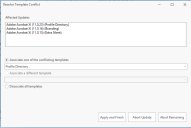Resolving Conflicts
Although it is rare, it is possible that two or more supersedence chains may become merged in an updated catalog. If the supersedence chains are associated with different Update Templates, a template conflict will occur. The conflict must be resolved before updates in the newly merged supersedence chain can be published. Any attempt to publish updates that are a part of a supersedence chain that contains a template conflict will result in errors being logged in the AutoPublish.log file.
You will be made aware of the template conflict when the Ivanti Patch grid is loaded. The Associated Template column for each affected update will display Template Conflict.
In addition, a Resolve Template Conflict dialog will be displayed. This dialog shows the names of updates from the previously separate supersedence chains along with the name of the template that is currently associated with each update.
There are several choices you can make on this dialog.
- Associate with one of the conflicting templates: Enables you to associate one of the conflicting templates to all updates in the new supersedence chain.
- Associate a different template: Enables you to associate a different template to all updates in the new supersedence chain.
- Dissociate all templates: No template will be associated with the new supersedence chain.
- Apply and Finish: The choice you made will be applied to the supersedence chain and the grid will be reloaded.
- Abort Update: The displayed conflict will not be resolved. Updates in the new supersedence chain will not be publishable.
- Abort Remaining: The displayed conflict as well as any other supersedence chain conflicts will not be resolved. Updates in the new supersedence chains will not be publishable.
If you choose Abort Update or Abort Remaining, the conflicts will be displayed in the Associated Template column in the grid. You can resolve the conflict from the grid by selecting an affected update and associating or dissociating a template. The Resolve Template Conflict dialog will be displayed again the next time the grid is refreshed.

